Stages of manufacturing a clasp prosthesis

Clasp prosthetics - This is an effective type of removable prosthetics.
Clasp dentures are used for partial or complete loss of teeth.
The advantages of such designs are reliability, ease of use and long service life.
Clasp dentures differ in the way they are attached to the patient’s preserved teeth.
They can be fixed with:
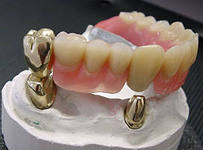
- Castles (attachments). One half of the castle is located on the clasp prosthesis, and the other on the abutment. Designs are characterized by high fixation and high aesthetics.
- Clasps. With their help, there is an attachment to the abutment teeth. With this method of attachment, aesthetics suffer, because a metal clasp in certain cases is installed only with access to the front teeth and falls into the smile line.
- Telescopic crowns.
Clasp prosthesis
The main elements of the clasp prosthesis are the arc, the saddle-shaped part of the structure on which the artificial teeth are located, devices for fixing the prosthesis. The arc (clasp) of the structure serves to connect all its parts into a single whole.
The prosthesis frame is made up of metal parts of the structure. The arc performs supporting, stabilizing and connecting functions.
Clasp prosthetics
Structural elements of clasp prostheses can be made of different materials. Clasp prostheses can have a metal or non-metallic frame.
The materials for the non-metallic parts of the structure are plastic, and the metal parts are stainless steel and metal alloys (chromium-cobalt, gold-platinum, etc.).
The disadvantage of the design made of stainless steel is that an oxide film forms at the point of soldering, which indicates the oxidation of solder in the oral cavity. An oxide film forms at the junction of the clasp with plastic or clasps.
In modern denture practice, brazed clasp structures are used less and less. They were replaced by dentures with a one-piece construction.
Clasp dentures with a monolithic frame are today considered the best.
Video: “A fundamentally new clasp prosthesis”
The main stages of manufacturing a clasp construction
- The clinical stage of the manufacture of prostheses.
- Manufacturing designs in the laboratory.
- Clinical stages of prosthetics:
- Examination of the patient. Before making arch prostheses, a patient treatment plan is developed in detail, the abutment teeth are determined and their preliminary preparation is carried out.
- Getting casts from both jaws of the patient. Impressions are removed with an individual spoon. In order to make a clasp structure it is recommended to get two prints from each jaw.
- After making prostheses in the laboratory, they are tested and, if necessary, corrected.
- The final fixation of the structure in the oral cavity.
Laboratory steps for making clasp prostheses
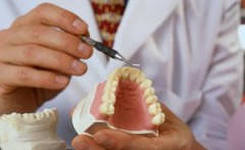
- Casting of models on finished impressions from gypsum with high strength (marble gypsum) so that they do not collapse when manipulated with them.
- Drawing a frame pattern of clasp construction.
- Production and modeling of the clasp prosthesis frame.
- Casting frame design. Grinding, polishing the frame.
- Fit the skeleton of the clasp prosthesis on the model.
- Modeling of the wax base, selection and installation of artificial teeth.
- Trying on the skeleton of the structure in the patient's oral cavity.
- Replacing wax with plastic, finishing the prosthesis (polishing, grinding).
- Fitting with overlay construction.
Manufacturing technologies for one-piece clasp prosthesis
The manufacture of clasp prostheses is possible only in the dental laboratory.
Clasp construction methods:
- Casting of the structure with removal of the wax blank from the model. According to this technology, the prepared construction from wax is removed from the gypsum model, packed into a refractory mass, wax is smelted and molten metal is poured into the vacant space.
- Casting construction on a refractory model. On a refractory gypsum model, a skeleton of an arch prosthesis is modeled from wax.
The technique of manufacturing clasp prostheses in the second way has the advantages that are characterized by the fact that metal shrinkage is eliminated and the possibility of deformation of the wax blank of the frame when it is removed from the model for packaging in a refractory mass is eliminated.
Designs created by the casting method are very light and accurate to manufacture, and therefore, do not require long-term addiction.
Denture Care
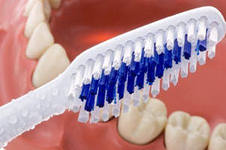
The care for the artificial teeth of the clasp prosthesis should be the same as for the real ones.
- The design must be removed from the mouth for hygienic treatment, but at the same time, it does not need to be removed at night.
- Hygienic treatment of the structure is required so that microbes do not develop under it.
- Before removing the prosthesis from the oral cavity, rinse your mouth with water. It is necessary to observe proper oral care. The design does not need to be put in a glass of water for storage.
Clasp denture life
The service life of structures, subject to operating requirements, is 5 years or more.
Under such constructions, bone and gingival tissues atrophy more slowly than when using prostheses made of plastic.
Cost of prosthetics with clasp constructions
Clasp prosthetics is today one of the popular methods for removable prosthetics.
The cost of the prosthesis depends on the complexity of its manufacture, on the materials used in the manufacture of the structure. The price of the dental structure will also depend on the type of attachment of the prosthesis to the teeth. The designs on locks are expensive, because they include the cost of locks, as well as crowns.
The cost of prosthetics can include services for preparing teeth for prosthetics: dental treatment, setting crowns on abutment teeth and taking impressions.
| Type of clasp prosthesis | Price in rubles |
| Simple clasp prosthesis | 15000 |
| Clasp prosthesis | 20000 |
| Splint clasp prosthesis | 20000 |
| Simple clasp closure design | 50000 |
| One-way clasp prosthesis with locks | 35000 |
Clasp patient reviews
Clinical prosthetics received positive reviews from patients by the following important criteria:
- Designs have a longer service life than other types of removable prosthetics.
- By reducing the basis of the prosthesis, the structures are more convenient to use, which prevents dysfunction, changes in taste and loss of structure from the oral cavity.
- Comfort and convenience when wearing a prosthesis.
- Reliability and structural strength due to the presence of a cast metal frame, which reduces the likelihood of structural failure.
Before and after photos
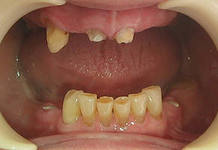 |
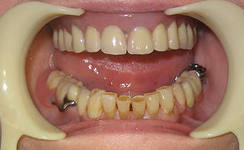 |
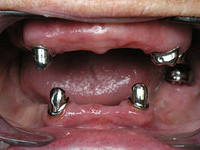 |
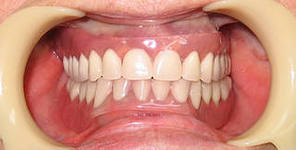 |
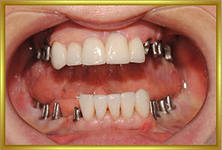 |
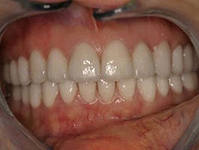 |